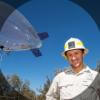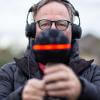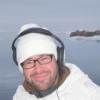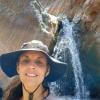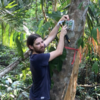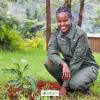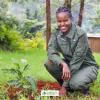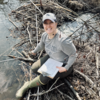Acoustic sensors enable efficient and non-invasive monitoring of a wide range of species, including many that are difficult to monitor in other ways. Although they were initially limited in application scope largely due to cost and hardware constraints, the development of low-cost, open-source models like the Audiomoth in recent years has increased access immensely and opened up new avenues of research. For example, some teams are using them to identify illicit human activities through the detection of associated sounds, like gunshots, vehicles, or chainsaws (e.g. OpenEars).
With this relatively novel dimension of wildlife monitoring rapidly advancing in both marine and terrestrial systems, it is crucial that we identify and share information about the utility and constraints of these sensors to inform efforts. A recent study identified advancements in hardware and machine learning applications, as well as early development of acoustic biodiversity indicators, as factors facilitating progress in the field. In terms of limitations, the authors highlight insufficient reference sound libraries, a lack of open-source audio processing tools, and a need for standardization of survey and analysis protocols. They also stress the importance of collaboration in moving forward, which is precisely what this group will aim to facilitate.
If you're new to acoustic monitoring and want to get up to speed on the basics, check out these beginner's resources and conversations from across the WILDLABS platform:
Three Resources for Beginners:
- Listening to Nature: The Emerging Field of Bioacoustics, Adam Welz
- Ecoacoustics and Biodiversity Monitoring, RSEC Journal
- Monitoring Ecosystems through Sound: The Present and Future of Passive Acoustics, Ella Browning and Rory Gibb
Three Forum Threads for Beginners:
- AudioMoth user guide | Tessa Rhinehart
- Audiomoth and Natterjack Monitoring (UK) | Stuart Newson
- Help with analysing bat recordings from Audiomoth | Carlos Abrahams
Three Tutorials for Beginners:
- "How do I perform automated recordings of bird assemblages?" | Carlos Abrahams, Tech Tutors
- "How do I scale up acoustic surveys with Audiomoths and automated processing?" | Tessa Rhinehart, Tech Tutors
- Acoustic Monitoring | David Watson, Ruby Lee, Andy Hill, and Dimitri Ponirakis, Virtual Meetups
Want to know more about acoustic monitoring and learn from experts in the WILDLABS community? Jump into the discussion in our Acoustic Monitoring group!
Header image: Carly Batist
No showcases have been added to this group yet.
- @chmod000
- | he/they
I build sensing and perceiving hardware that is designed to address issues that matter to me. That ranges from assistive technologies, to conservation ecology, and connecting individuals with place and each other.
- 0 Resources
- 0 Discussions
- 7 Groups
- @AliceMuller
- | she/her
I am an environmental scientist working in international community development and community led ecosystem restoration
- 0 Resources
- 0 Discussions
- 1 Groups
- @EliThore
- | He/Him
Swedish University of Agricultural Sciences
I am a biologist with a broad interest in how the environment affects the behaviour and ecology of wildlife. I also like seeking creative and practical solutions to reduce our impact on the environment.
- 0 Resources
- 0 Discussions
- 5 Groups
- @Theresa
- | she/her/hers
- 0 Resources
- 0 Discussions
- 3 Groups
- 1 Resources
- 0 Discussions
- 7 Groups
- @fmnrandrew
- | he, him
I hold a PhD in terrestrial ecology (2010) and am an Adjunct Research Fellow at Charles Sturt University. I also work with World Vision Australia as Monitoring Coordinator for a project called "Scale Up FMNR" which is short for "Farmer Managed Natural Regeneration"
- 0 Resources
- 2 Discussions
- 2 Groups
- @Iniunam
- | He
Conservation Biologist, Data Analyst and Bioacoustics enthusiast
- 0 Resources
- 0 Discussions
- 3 Groups
- @sbombaci
- | she/her/hers
I study acoustic ecology, community ecology, and social justice in conservation
- 1 Resources
- 1 Discussions
- 3 Groups
- @garthpaine
- | He/Him
Arizona State University
Garth Paine (https://www.activatedspace.com/ ) is acoustic ecologist, composer, sound artist, and academic (ASU) based in USA/Australia. He is known for his pioneering work on species density metrics from ambient recordings and his anti-poaching efforts
- 1 Resources
- 0 Discussions
- 5 Groups
- @Xavier_Mouy
- | he/him
I build software and hardware tools to help the analysis or the collection of passive acoustic data.

- 1 Resources
- 7 Discussions
- 6 Groups
Researcher interested in the conservation of endemic anurans from arid High Andes. Focused on behavior, ecology, physiology, and reproduction studies. Education for conservation.
- 0 Resources
- 0 Discussions
- 7 Groups
- @CarlosAbrahams
- | He/him
Baker Consultants
Director of Bioacoustics and Senior Lecturer



- 2 Resources
- 26 Discussions
- 4 Groups
Ol Pejeta Conservancy partners with conservation and technology organisations to kick-start a research and innovation centre for wildlife conservation
31 May 2019
In February, we released an open call for the WILDLABS TECH HUB, offering 3 months of support for solutions using technolgy to tackle the illegal wildlife trade. We were overwhelmed by an incredible 37 submissions,...
13 May 2019
Happy World Wildlife Day! To celebrate, this week we've asked our community to share photos showing how they are using tech in the field or the lab, using the #Tech4Wildlife hashtag.
3 March 2019
In this case study, Science Reporter Jamie Morton tells the story of how Kiwi scientists are teaming up with a local underwater robotics company to gain world-first insights into the lives of whales in Antarctica.
4 February 2019
As human impacts on the world accelerate, so does the need for tools to monitor the effects we have on species and ecosystems. In this article, Ella Browning and Rory Gibb share insights from their recent review paper...
4 December 2018
Article
In this case study, conservation ecologist Ayesha Tulloch takes us behind the scenes of her recent paper, which came out in Nature Ecology & Evolution earlier this month. In this paper, Ayesha and her team present a...
20 August 2018
Last month, the 2018 Ecoacoustics Congress was held in Brisbane. Bringing together scientists, natural resource managers, industry and artists, participants explored the ways that sound can deepen our understanding of...
25 July 2018
This latest chapter in the Conservation Technology Series from WWF-UK looks at the opportunities, challenges and state-of-the-art of satellite remote sensing for conservation applications. This issue reviews available...
23 April 2018
Hundreds of people joined our #Tech4Wildlife photo challenge this year, showcasing all the incredible ways tech is being used to support wildlife conservation. We've seen proximity loggers on Tasmanian Devils in...
3 March 2018
Our panel of international experts has been hard at work reviewing the 47 proposals we recieved for innovative technological tools to address human wildlife conflict. The panelists have systematically been assessing the...
20 October 2017
The inherent complexity of not only deploying technologies in the field but also doing so in a scientifically rigorous manner can prove a substantial barrier for the effective use of conservation technologies, and clear...
11 October 2017
Its been a busy couple of months for the Open Acoustic Devices team. They've just returned back from Belize where they have been trialling the new AudioMoth design for gunshot detection. Find out what they've been up to...
27 June 2017
August 2025
event
September 2025
event
October 2025
November 2025
event
December 2020
June 2020
64 Products
Recently updated products
| Description | Activity | Replies | Groups | Updated |
|---|---|---|---|---|
| We actually recently introduced Recording Schedules - where you can control the PUC's duty cycle during (Day, Night, Dawn, Dusk). |
|
Acoustics | 11 months 3 weeks ago | |
| Hey Xavier! Thank you for your interest and question!! The overarching goal of the FinDrop v1 for the WildLabs award is to characterize an instrument and make it as, if... |
|
Acoustics, Build Your Own Data Logger Community, Marine Conservation, Protected Area Management Tools, Sustainable Fishing Challenges | 11 months 3 weeks ago | |
| The main takeaway from this particular localization was that a gunshot was able to be detected considerably further than I previously thought. 2.7km is really far I think for a... |
|
Acoustics | 1 year ago | |
| Hi Nick,Yes, It's very common to have big data in the SD cards when recording bats!I agree with Carly's comments. Indeed, I suggest you make a schedule so you do not record... |
|
Acoustics | 1 year ago | |
| So excited for this! These topics are all super relevant and comprehensive. Maybe one thing that might be interesting to hear about is projects where PAM is combined with... |
|
Acoustics | 1 year ago | |
| Hi Stefan,Sorry, I'm not sure I fully understand your question.If you're referring to my first comment, the package I initially tried didn't work with my dataset. The likely... |
+8
|
Acoustics | 1 year ago | |
| Hi there Loveness, I agree there is a ton to learn with acoustic monitoring! Here's my favorite website for learning the (many) basics! Discovery of Sound in the SeaHave... |
|
Acoustics | 1 year ago | |
| Karibu sana |
|
Acoustics, East Africa Community, Conservation Tech Training and Education | 1 year ago | |
| Hi César, Is there a geographic area you're limited to? That would help to narrow down options. I would recommend reaching out perhaps to the Kitzes Lab, Sound Forest... |
|
Acoustics, Citizen Science, Community Base, Early Career, Marine Conservation | 1 year ago | |
| Retweet on OpenSoundscape - great package and documentation that allows you to build your own CNNs! Note that this is in Python though. There are tons of bioacoustics... |
|
Acoustics, Data management and processing tools | 1 year ago | |
| Hi @BrettMargoSupplies this product seems like a fantastic addition to The Inventory, WILDLABS' wiki-style discovery platform for conservation technology. Adding a product is... |
|
Acoustics | 1 year ago | |
| Hi everyone, I am conducting a research project as part of my MSc in Environment and Development at the London School of Economics. I... |
|
Acoustics, AI for Conservation, Autonomous Camera Traps for Insects, Ethics of Conservation Tech | 1 year ago |




